
Christ Church Anglican Church, Bundaberg
[Photograph by Trevor Bunning (November 2010)]

Christ Church Anglican Church, Bundaberg
[Photograph by Trevor Bunning (November 2010)]
Historical and Technical Documentation by Geoffrey Cox
© OHTA , 2011, 2019 (last updated July 2019)
The Bundaberg district was explored by Europeans searching for timber in the 1850s and 1860s, and developed from the 1870s onwards as one of Australia's major sugar-producing areas. The Bunda Aborigines gave the city the first part of its name, while the second part "Berg" (German for 'mountain') points to the preponderance of early German settlers.
The first Anglican Church in Bundaberg was built in Quay Street in 1876. The building was moved to Woongarra Street, near the present site, in 1899. The present brick church, in English gothic style with prominent bell tower and spire, was built in 1926 and dedicated in February 1927.1 Plans for the building had been drawn up in the 1890s by the architect, J. H. Buckeridge (1857-1934), a pupil of J. L. Pearson, who was the Diocesan Architect of the Anglican Diocese of Brisbane between 1887 and 1902.2

First Christ Church Anglican Church, Bundaberg, ca. 1910
[Photograph: John Oxley Library, State Library of Queensland]
The organ was built in 1902 by M.P. Möller of Hagerstown, Maryland, U.S.A. It is one of only three instruments exported to Australia by this firm. The other two, for the Chapel of the Maternal Heart of Mary, Lewisham, NSW (1927) and the Congregational Church, Mosman, NSW (1929), represent a later phase of the firm's work.3 The Bundaberg organ was installed in the old church in November 1902, and dedicated in memory of The Rev'd William Morris, the first Rector of the parish from 1878,4 who died in 1900.5

The Möller Opus Number inside the Casework
[Photograph posted 14 April 2018 on Facebook page of Pierce Pipe Organs:
www.facebook.com/Pierce-Pipe-Organs-137138762970557/]
The organ builder's opus number (No 387) is located inside the casework, and the original specification was as follows:
| GREAT Open Diapason Dulciana Melodia St. Unison Bass Gemshorn SWELL Violin Diapason Stopped Diapason Treble Stopped Diapason Bass Flute d'Amour Oboe PEDAL Bourdon COUPLERS Swell to Great Great to Pedal Swell to Pedal |
8 8 8 8 4 8 8 8 4 8 16 |
[Tenor C] [Tenor C] [12 notes] [Tenor C] [Tenor C] [12 notes] [Tenor C] |
Swell tremulant
Mechanical action
Compass: 61/30
Drawstop console
Pedalboard: straight
2 composition pedals to Great
Balanced swell pedal (brass shoe)6
The organ builder's nameplate appears on the console, and the name 'Möller' is also cast into the brass Swell shoe. The Pedal Bourdon pipes are fitted with regulating handles in the feet, and the drawstops are distinctively oblique-faced, arranged in terraced jambs. Above the Swell manual there is a wind indicator in the form of a small circular window, and a "Blower Signal" is included amongst the right-hand drawstops.
The organ was removed in 1927 by Whitehouse Bros of Brisbane from the old church and re-erected in its present position in a loft to the north side of the chancel, with new front speaking pipes.7 The old front pipes by Möller were re-used as non-speaking showpipes in the north aisle.
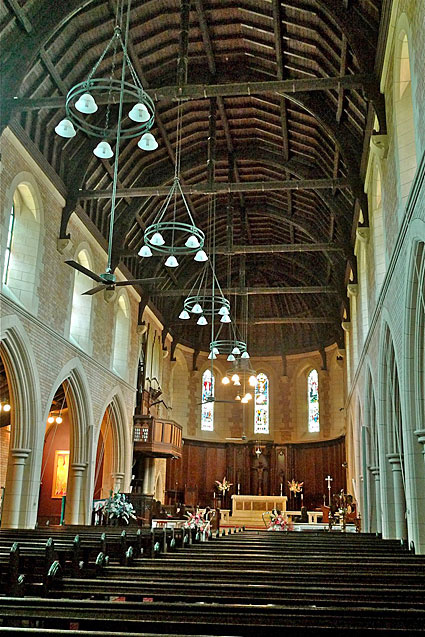

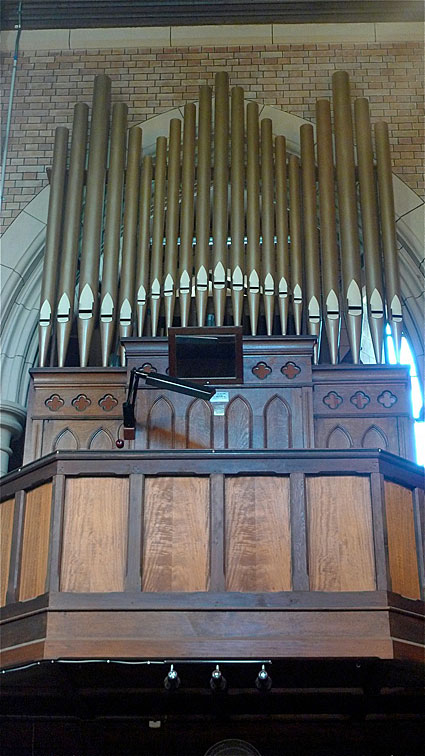
The organ in the loft of the new church
[Photographs by Trevor Bunning (Nov 2010)]

View from the organ loft in the new church
[Photograph by Trevor Bunning (Nov 2010)]
Changes to the organ in 1963 by the Charles Dirksen Organ Co. of Brisbane involved a compromise between conservation and inexpensive enlargement. Mechanical action was retained in the existing parts of the organ, but a secondary electric-action swell division, comprising 4 ranks extended and an independent Mixture, was added in a separate box. This incorporated the original Swell Violin Diapason 8ft, which was used as the basis for the Gamba rank in the new division, leaving a spare slide on the original Swell chest. The new swellbox operated electro-pneumatically from the original swell (shoe) pedal, and Dirksen also added 3 pistons to the new swell division.8
| SECONDARY SWELL Open Diapason Gamba Principal Gamba Gamba Mixture Trumpet Trumpet Clarion |
8 8 4 4 2 II 16 8 4 |
A B C B B D D D |
(added 1963) [original Swell Violin Diapason] [Tenor C] |
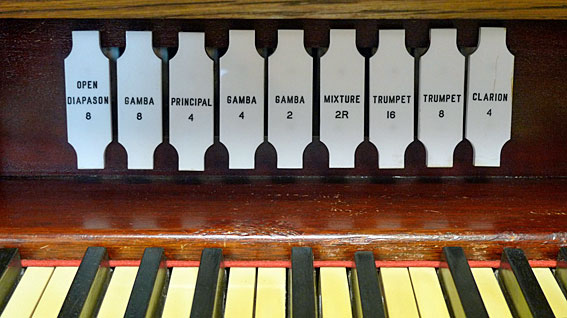
Dirksen's stopkeys operating the Secondary Swell division
[Photograph by Trevor Bunning (Nov 2010)]
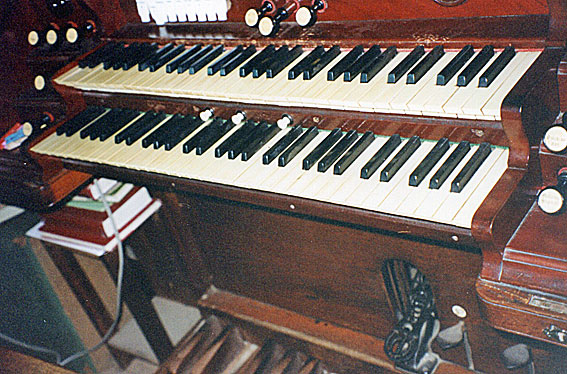
Console of the Möller organ
[Photograph by Howard Baker (1990s)]
The independent 2-rank Mixture added in 1963 to the Bundaberg organ has since been revealed to have been made up of pipework from the 1884 J.W. Walker organ at St Andrew's South Brisbane,9 where Charles Dirksen replaced the original Swell 3-rank Mixture (in which all the ranks broke at middle C) with a completely new Mixture in 1961.10
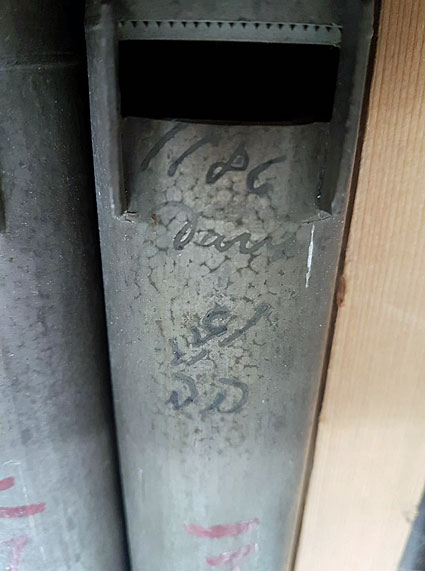
The bottom C pipe of the Mixture added by Charles Dirksen in 1963,
showing J.W. Walker's job number 1186 on the lip
[Photograph posted 10 June 2018 on the facebook page of Pierce Pipe Organs:
www.facebook.com/Pierce-Pipe-Organs-137138762970557/]
The organ was repaired and overhauled in 1992 by W.J. Simon Pierce of Brisbane.11
The scale of the organ's sound in the new building continued to cause concern, and Dirken's makeshift additions of 1963 were proving to be mechanically and tonally unsatisfactory. In 1996, Pierce restored the action, and at the same time added two stops (Principal 4ft & Fifteenth 2ft) on the original Great soundboard, using pipework from the 1881 Forster & Andrews organ, formerly at the Great Hall, University of Sydney.12 The original Great Dulciana 8ft was placed in storage in the loft, and the Gemshorn 4ft was moved from the Great to the Swell, where it occupied the slide originally intended for the Violin Diapason.13
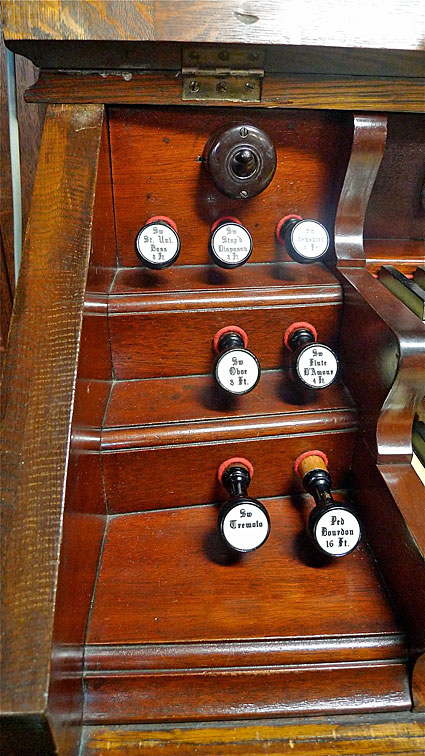

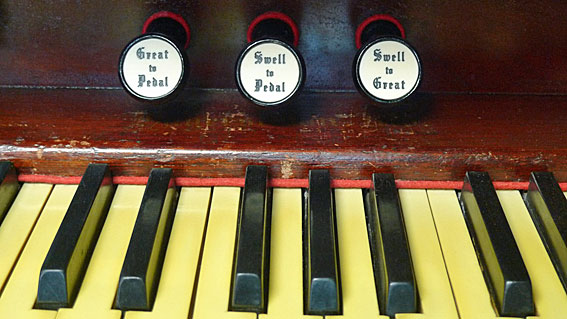
Modified Möller stop jamb after 1996
[Photographs by Trevor Bunning (Nov 2010)]
Refurbishment of the organ in 2018-19 by Pierce Pipe Organs of Brisbane involved a comprehensive rationalisation of the Swell division. The Swell Violin Diapason 8ft was returned to its original position, and the original mechanical-action Swell soundboard was enlarged to accommodate the Gemshorn 4ft (originally on the Great), the Mixture II (J.W. Walker pipework of 1884; added by Dirksen in 1963) and Dirksen's Trumpet 8ft (1963). Dirksen's 1963 secondary Swell was removed. The original console has been retained, with the addition of drawstops sourced from a redundant M.P. Möller organ in the United States.14
The fully refurbished organ was opened with a recital by Andrej Kouznetsov on 22 March 2019, including works by Bach, Brahms, Mendelssohn and others.15
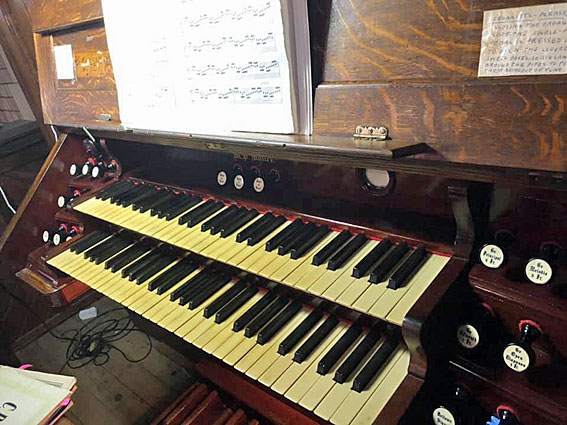
The re-ordered Möller console (March 2019)
[Photograph by Andrej Kouznetsov, posted 25 March 2019
on the facebook page of Pierce Pipe Organs:
www.facebook.com/Pierce-Pipe-Organs-137138762970557/ ]
The re-ordered and enlarged specification, following the 1996 and 2018 changes, is as follows:
| GREAT Open Diapason Melodia St[op'd] Uni[son] Bass Principal Fifteenth SWELL Violin Diapason Stop'd Diapson St[op'd] Uni[son] Bass Gemshorn Flute d'Amour Mixture Trumpet Oboe PEDAL Bourdon COUPLERS Swell to Great Great to Pedal Swell to Pedal |
8 8 8 4 2 8 8 8 4 4 II 8 8 16 |
[Tenor C] [12 notes] [1996, from University of Sydney (Forster & Andrews)] [1996, from University of Sydney (Forster & Andrews)] (enlarged mechanical-action soundboard) [Tenor C; returned 2018 from the 1963 Secondary Swell] [Tenor C] [12 notes] [moved 1996 from Great] [Walker 1884 / Dirksen 1963] [Dirksen 1963] [Tenor C] |
Swell tremulant
Compass: 61/30
Mechanical action
Draw-stop console
Pedalboard: straight
2 composition pedals to Great
Balanced swell pedal (brass shoe)
Original Dulciana 8 [Tenor C] in storage.16
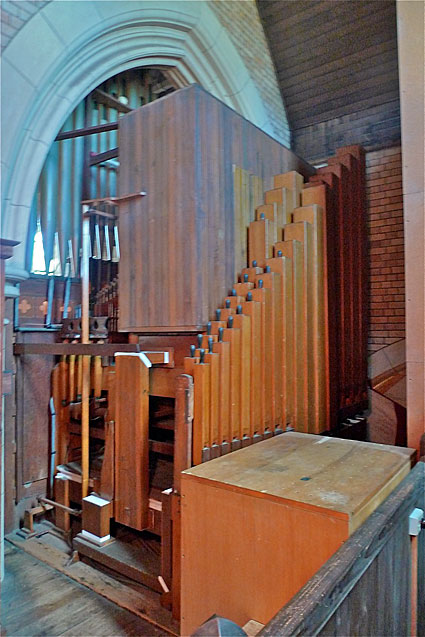
[Photograph by Trevor Bunning (November 2010)]
1 Glenda Murrell, Anglican Records and Archive Centre Guide to Records (DioceseofBrisbaneWeb, 2001) - accessed January 2004; Bundaberg Heritage Walks http://www.bundabergregion.info – accessed February 2004.
2 Donald Watson & Judith McKay, Queensland Architects of the 19th Century: A Biographical Dictionary (Brisbane: Queensland Museum, 1994), pp. 25-26; The Brisbane Courier (12 February 1927), p. 9.
3 Pastór de Lasala, 'Sydney's Twin Möller Organs,' The Sydney Organ Journal, vol. 49, no. 3 (Winter 2018), pp. 39-42.
4 Plaque on the organ case.
5 Personal communication to G. Cox from Mrs Jean Dunn (organist), 28 August 1974.
6 Original contract (dated 11 December 1901) supplied to G. Cox by Jack Staley of M.P. Möller, Inc., August 1974. Simon Pierce has observed (June 2018) that the pipes of the Violin Diapason are marked "Viola Diap".
7 Whitehouse Bros Ledger (1922-1940), p. 90.
8 1963 details from church records supplied to G. Cox by Mrs Jean Dunn (organist), August 1974.
9 Observations by Simon Pierce, posted 10 June 2018 on the facebook page of Pierce Pipe Organs,
www.facebook.com/Pierce-Pipe-Organs-137138762970557/
10 Details supplied to G. Cox by Edward R. Salisbury (organist at South Brisbane, 1949-62) c.1973.
11 The Organ Voice, vol. 19, no. 6 (June 1992), p. 39.
12 Graeme Rushworth, Historic Organs of New South Wales (Sydney: Hale & Iremonger, 1988), pp. 242-44; Geoffrey Cox, Kelvin Hastie and John Maidment, Lost Pipe Organs of Australia: A Pictorial Record (Organ Historical Trust of Australia & Xlibris, 2017), pp. 54-55.
13 Personal communication to G. Cox from W.J. Simon Pierce, 1997. The 1996 additions and alterations are incompletely described in The Organ Voice, vol. 24, no. 3 (September 1998), p. 12, but corrected in vol. 24, no. 4 (December 1998), p. 28.
14 Personal communication to G. Cox from Simon Pierce, 16 June 2018 and 4 July 2018, and details posted 14 April 2018 on the facebook page of Pierce Pipe Organs, www.facebook.com/Pierce-Pipe-Organs-137138762970557/
15 Details posted 23 and 25 March 2019 on the facebook page of Pierce Pipe Organs,
www.facebook.com/Pierce-Pipe-Organs-137138762970557/
16 Specification noted by G. Cox, July 1974, here incorporating the 1996 and 2018 changes, as noted above.
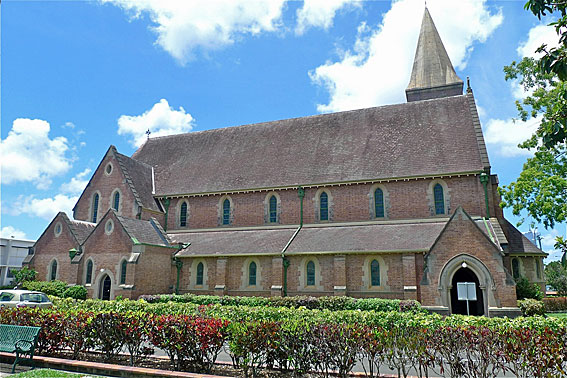

[Photographs by Trevor Bunning (November 2010)]